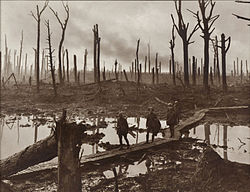
A boardwalk (alternatively board walk, boarded path, or promenade ) is an elevated footpath, walkway, or causeway typically built with wooden planks, which functions as a type of low water bridge or small viaduct that enables pedestrians to better cross wet, muddy or marshy lands. [1] Such timber trackways have existed since at least Neolithic times.
Contents
In many seaside resort locations, boardwalks along the beach provide access to shops, hotels, and tourist attractions. The Jersey Shore in the United States is especially noted for its abundance of boardwalks.
Some wooden boardwalks have had sections replaced by concrete and even "a type of recycled plastic that looks like wood." [2]










